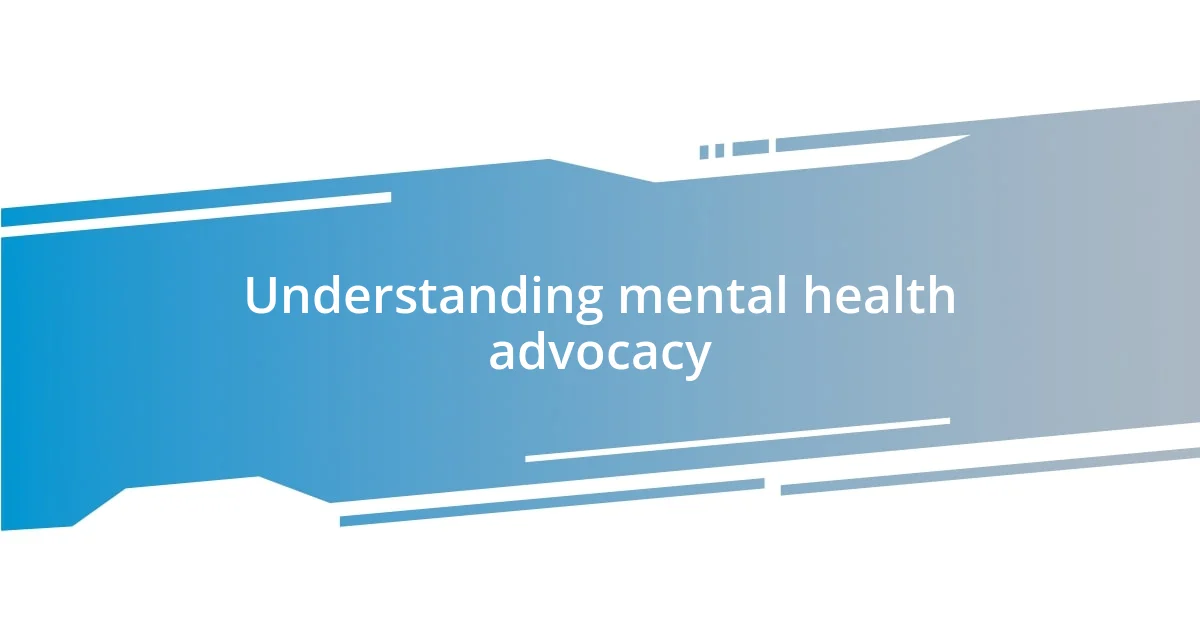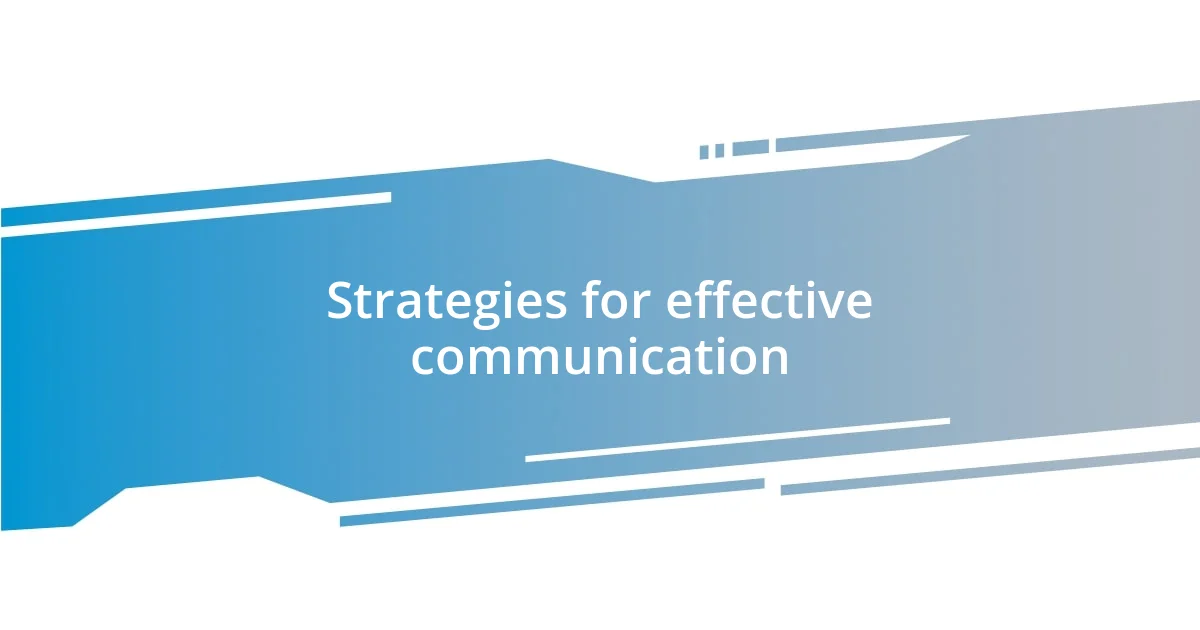Key takeaways:
- Mental health advocacy fosters understanding and empathy, emphasizing the importance of listening and sharing personal experiences to reduce stigma.
- Engaging with communities and building supportive networks enhances collective healing and empowers individuals to open up about their struggles.
- Utilizing social media effectively promotes awareness, creates virtual support networks, and facilitates real-time discussions that connect and inspire others.

Understanding mental health advocacy
Mental health advocacy is often misunderstood, yet it plays a vital role in shaping how society perceives and supports mental well-being. From my own experience, I recall advocating for a friend who struggled with anxiety. I remember feeling a mix of frustration and urgency as I worked to educate others about her condition and the importance of compassion. Wouldn’t it be incredible if we all took a moment to truly understand what someone with a mental health issue is going through?
Sometimes, advocacy means simply being there for someone, listening to their stories without judgment. There was a time when I sat with a colleague breaking down about her struggles. In that moment, I realized how powerful our willingness to listen can be. It made me wonder, how often do we overlook the quiet battles that others face every day?
Implicit in mental health advocacy is the pursuit of awareness and policy changes that can lead to better support systems. Reflecting on my journey, I’ve engaged in many campaigns aimed at reducing stigma. I often found myself asking—what does it take for society to shift its perspective on mental health issues? I believe that each small conversation contributes to a much larger narrative, ultimately fostering understanding and empathy among us all.

Importance of personal experiences
Sharing personal experiences in mental health advocacy can be a powerful tool for change. I remember a time when I spoke publicly about my own struggles with depression. The feedback was overwhelming; people reached out to share their own stories, and that connection created an empowering space where vulnerability was met with understanding. I realized then how our individual journeys can inspire others to open up and contribute to a collective healing process.
- Personal anecdotes humanize the issue and challenge misconceptions.
- Sharing our stories can reduce feelings of isolation for others.
- They create a sense of community, fostering support among those facing similar challenges.
- By opening up, we can shift narratives around mental health, encouraging dialogue and understanding.

Strategies for effective communication
One fundamental strategy for effective communication in mental health advocacy is being clear and direct. I recall a conversation I had with a family member about depression. At first, I tiptoed around the topic, unsure of how they’d react. But once I spoke candidly about my feelings, it opened a floodgate of honest communication between us. Clear language is essential—it creates a safe space where everyone involved can feel understood and valued.
Another vital approach lies in active listening. I remember participating in a support group where each person shared their experiences. Instead of offering immediate solutions, we were encouraged to listen intently. The difference was palpable; people felt seen and heard. By focusing on understanding rather than responding, we foster deeper connections and trust. It’s a reminder that sometimes, the most effective communication doesn’t require speaking at all.
Utilizing non-verbal cues can be equally impactful. During a workshop on mental health, I noticed how a simple nod or eye contact could encourage others to share. Even holding a person’s gaze in a conversation can significantly convey empathy and understanding. When we complement our words with genuine non-verbal communication, we can profoundly connect with others on their mental health journeys.
| Strategy | Description |
|---|---|
| Clear Communication | Use direct language to convey feelings and experiences. |
| Active Listening | Focus on being present and understanding others’ emotions without rushing to provide answers. |
| Non-Verbal Cues | Utilize eye contact and body language to support verbal communication, enhancing connection. |

Building a supportive network
When it comes to building a supportive network, I’ve come to realize that the right people can make all the difference. I remember a time when I was feeling particularly low, and I decided to reach out to a couple of friends who’d been through similar struggles. The moment I shared what I was going through, their immediate empathy and understanding lifted such a heavy weight off my shoulders. Have you ever felt that sense of relief when someone truly “gets” what you’re enduring? It’s remarkable how fostering genuine connections can create a safe haven where we can be vulnerable without fear of judgment.
It’s also crucial to recognize that a supportive network doesn’t have to be vast; quality matters just as much—if not more—than quantity. I once attended a small gathering of like-minded individuals, and I was shocked at how quickly trust blossomed among us. We shared laughter, tears, and stories, and it felt like we were all carrying a piece of each other’s burdens. This taught me that even one or two strong connections could nurture the kind of environment that encourages open dialogue about mental health, making each person feel they belong.
Creating a supportive network is not just about finding others who understand; it’s about being there for one another in tangible ways. I’ve learned that sometimes, a simple text checking in can make someone’s day a little lighter. Have you considered how one small act of kindness can ripple out and affect someone’s mental health journey? Each gesture of support fosters resilience in ourselves and those around us, reinforcing the importance of community in our lives.

Engaging with local communities
Engaging with local communities has been one of the most rewarding aspects of my mental health advocacy journey. I remember the first time I volunteered at a mental health fair in my neighborhood. It was amazing to see the diverse range of people who attended; some were seeking help, while others just wanted to learn more. That day, I realized that when communities come together, they not only empower each other but also create an informed network that breaks down stigma. Have you ever witnessed firsthand how local events can spark conversations that matter?
I’ve also found that hosting workshops can be incredibly impactful. In one session, we created a safe space for discussion by sharing personal stories related to mental health challenges. I shared my own experience with anxiety, and when others opened up about their struggles, a profound sense of solidarity emerged. It’s interesting how vulnerability fosters connection; suddenly, we weren’t just individuals facing our battles alone. We became a cohesive unit supporting one another, transcending mere participation to cultivate genuine community bonds.
Moreover, partnering with local organizations enhances outreach efforts significantly. Collaborating with schools and community centers has allowed me to tap into resources I wouldn’t have accessed alone. Once, while working with a youth organization, we organized a panel discussion that drew in teens who were eager to talk about their mental health. The energy in the room was electric! It struck me how necessary it is to involve young voices in these discussions, and it reinforced my belief that engaging local communities can lead to real, meaningful change in mental health awareness. Have you thought about the power of combining different community resources to foster a richer understanding of mental health?

Promoting awareness through social media
Social media has become a powerful tool in promoting mental health awareness, and I’ve seen its impact firsthand. I remember when I started sharing snippets of my own mental health journey on platforms like Instagram; the response was overwhelming. People reached out to me not just to share their stories but to express gratitude for normalizing conversations that often feel taboo. Isn’t it fascinating how a simple post can bridge the gap between isolation and community?
Engaging with my followers has created a sense of accountability for me. I often host live sessions where we discuss various mental health topics—from coping strategies to the importance of seeking professional help. During one particular session, a viewer opened up about their struggles with depression and how they’ve felt silenced for years. It was incredible to witness so many join in to support them, reflecting the collective power of sharing. Have you ever imagined how these real-time discussions can foster vulnerability and connection among strangers scattered around the globe?
Through social media campaigns, I’ve been part of initiatives that encourage people to share their mental health experiences using specific hashtags. One campaign I participated in had participants write a quick note to their past selves, and I was deeply moved by the messages people shared. It reminded me that we all have battles behind closed doors. This collective sharing not only educates others but also creates a virtual support network that can be just as impactful as any physical community. Have you ever thought about how your own experiences could spark change in someone else’s life through social media? Each story has the potential to resonate and help someone feel a little less alone.

Measuring impact and success
Measuring the impact of my advocacy efforts has been an eye-opening experience. One tangible metric I often utilize is the feedback from participants after workshops or events. For instance, during one workshop, a participant told me how our conversations encouraged him to seek therapy for the first time. Hearing someone share that my efforts made a difference in their mental health journey was incredibly fulfilling. Have you felt that rush of joy when you realize your work has genuinely helped someone?
Another critical aspect of measuring success is observing the transformations within the community over time. I’ve seen attendance at mental health events grow exponentially, showing that the conversation is indeed shifting. It’s encouraging to witness more people openly discussing their mental health challenges now compared to just a few years ago. This gradual change in mindset signals to me that our efforts are making a lasting impact. Isn’t it fascinating how sometimes success isn’t just about numbers but rather a broader cultural shift?
Lastly, I often reflect on personal anecdotes that underscore the ripple effect of mental health discussions. On one occasion, a young woman approached me at an outreach event, sharing how she had encouraged her parents to join a local support group after hearing me speak. It struck me then how one conversation can inspire others to take action. The interconnectedness of our stories speaks to a bigger picture, where measuring success isn’t solely about metrics but about fostering individual courage to seek help and support one another. Have you considered how your own narrative might influence someone else’s journey?














